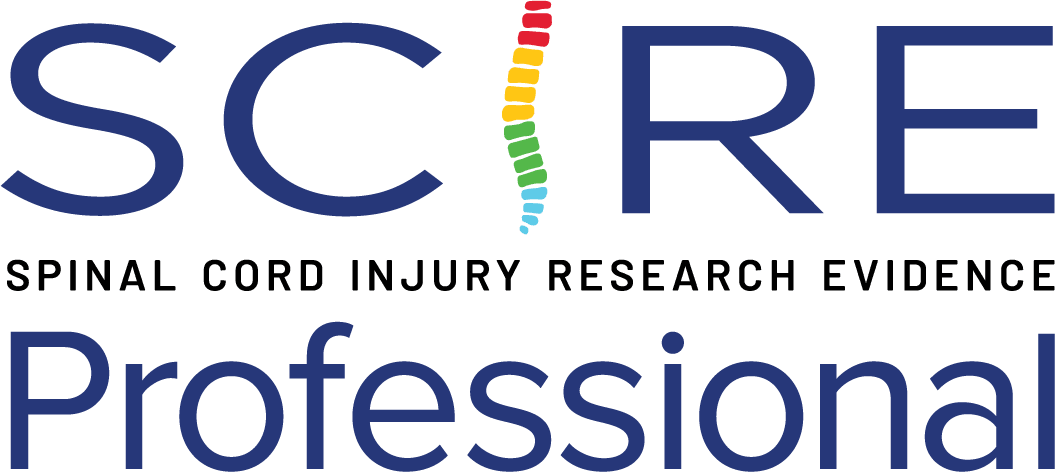- Manual Muscle Testing (MMT) is a clinician-administered measure of muscle strength
- Three different versions of grading scales for the MMT have been developed to date, each of which can be found below, in the Availability section
Clinical Considerations
The MMT has since been adapted for use as the ASIA Motor Score, and for muscle strength testing in the Graded Redefined Assessment of Strength, Sensibility, and Prehension (GRASSP).
ICF Domain
Body Functions ▶ Neuromuscular Functions
Administration
- Each muscle or muscle group is individually tested, and rated in terms of strength against gravity and/or resistance
- Administration time depends on the muscle tested; <1 minute for each muscle
Number of Items
N/A
Equipment
Does not require any specialized equipment.
Scoring
- Each muscle is rated 0-5
- Higher scores indicate greater strength
Grade Description
0: Complete lack of voluntary muscle contraction. The examiner is unable to feel or see any muscle contraction
1: Faint or “flicker” muscle contraction without any movement of the limb. The examiner can see or palpate some contractile activity of the muscle/s or may be able to see or feel the tendon “pop up” or tense as the person tries to perform the contraction.
2-: Gravity eliminated movement that is less than full range of motion. Very weak muscle contraction with movement through complete range of motion in a position that eliminates or minimizes the force of gravity.
2+: In gravity minimized position, completes full available range and holds end position against mild resistance; or against gravity, completes up to half of the full range of motion.
3-: Against gravity, more than half but less than full range of motion. Muscle can complete a full range of motion against only the resistance of gravity.
3+: Completes full range of motion against gravity, and holds end position against mild resistance.
4: Able to complete the full range of motion against gravity and can tolerate strong resistance without breaking the test position. Muscle clearly breaks with maximal resistance.
5: Able to complete full range of motion and maintain end point range position against maximal resistance. The examiner cannot break the participant’s hold position.
Languages
English
Training Required
No formal training is required, but should be administered by professionals.
Availability
Refer to:
- Daniels and Worthingham’s Muscle Testing protocol
- Muscles Testing and Function (Kendall & McCreary)
- Aids to the examination of the peripheral nervous system (Medical Research Council)
- https://www.physio-pedia.com/Daniels_and_Worthingham%27s_Muscle_Testing
# of studies reporting psychometric properties: 9
Interpretability
MCID: not established in SCI
SEM: not established in SCI
MDC: not established in SCI
Reliability – High
- Inter-rater Reliability:
Agreement = 82%-84%
(Savic et al. 2007; n=45; 38 males, 7 females; 24 AIS-A, 13 AIS-D, 29 thoracic)
Agreement of wrist extensors and elbow flexors = 0.96, 094
(Bye et al. 2021; n=60; 48 males, 12 females; mean age: 55 years; ASIA: 17A, 14B, 13C, 16D; median (IQR) time since injury: 4 (1.5 to 24) months)
Validity – Moderate to High
- High correlation with Spinal Cord Independence Measure (SCIM III):
- Sum of MMT scores from multiple upper-limb muscles with:
SCIM Self-care items: r = 0.70-0.89
SCIM Self-care total: r = 0.84
SCIM Respiration & Sphincter: r = 0.68
SCIM Mobility: r = 0.71
SCIM Total: r = 0.78 - Single upper-limb muscle MMT scores with SCIM Self-care total:
r = 0.36-0.82
- Sum of MMT scores from multiple upper-limb muscles with:
(Rudhe et al. 2009; N=29; 16 males; ASIA A-D; mean (SD) time since injury: 4.5 (3) months)
- Moderate to High correlation with Walking Index for SCI (WISCI):
WISCI Level: r = 0.647-0.663
WISCI Speed: r = 0.494-0.539
(Burns et al. 2011; n=75; 79% males; tetraplegia and paraplegia; patients able to ambulate ≥10m, 88% AIS-D)
Responsiveness
No values were reported for the responsiveness of the MMT for the SCI population.
Floor/Ceiling Effect
No values were reported for the presence of floor/ceiling effects in the MMT for the SCI population.
Reviewers
Dr. Vanessa Noonan, Dr. Carlos L. Cano-Herrera, Elsa Sun
Date Last Updated
31 December 2024
Beninato M, O’kane KS, Sullivan PE. Relationship between motor FIM and muscle strength in lower cervical-level spinal cord injuries. Spinal Cord. 2004;42(9):533-40.
http://www.ncbi.nlm.nih.gov/pubmed/15224086
Burns AS, Delparte JJ, Patrick M, Marino RJ, Ditunno JF. The reproducibility and convergent validity of the walking index for spinal cord injury (WISCI) in chronic spinal cord injury. Neurorehabil Neural Repair. 2011;25(2):149-57.
http://www.ncbi.nlm.nih.gov/pubmed/21239706
Bye E, Glinsky J, Yeomans J, Hungerford A, Patterson H, Chen L, Harvey L. The inter-rater reliability of the 13-point manual muscle test in people with spinal cord injury. Physiother Theory Prac. 2021;37(10)1126-1131
https://pubmed.ncbi.nlm.nih.gov/31674263/
Fujiwara T, Hara Y, Akaboshi K, Chino N. Relationship between shoulder muscle strength and functional independence measure (FIM) score among C6 tetraplegics. Spinal Cord. 1999;37(1):58-61.
http://www.ncbi.nlm.nih.gov/pubmed/10025698
Herbison GJ, Isaac Z, Cohen ME, Ditunno JF. Strength post-spinal cord injury: myometer vs manual muscle test. Spinal Cord. 1996;34(9):543-8.
http://www.ncbi.nlm.nih.gov/pubmed/8883189
Noreau L, Vachon J. Comparison of three methods to assess muscular strength in individuals with spinal cord injury. Spinal Cord. 1998;36(10):716-23.
http://www.ncbi.nlm.nih.gov/pubmed/9800275
Rudhe C, Van hedel HJ. Upper extremity function in persons with tetraplegia: relationships between strength, capacity, and the spinal cord independence measure. Neurorehabil Neural Repair. 2009;23(5):413-21.
http://www.ncbi.nlm.nih.gov/pubmed/19261766
Savic G, Bergström EM, Frankel HL, Jamous MA, Jones PW. Inter-rater reliability of motor and sensory examinations performed according to American Spinal Injury Association standards. Spinal Cord. 2007;45(6):444-51.
http://www.ncbi.nlm.nih.gov/pubmed/17387316
Schwartz S, Cohen ME, Herbison GJ, Shah A. Relationship between two measures of upper extremity strength: manual muscle test compared to hand-held myometry. Arch Phys Med Rehabil. 1992;73(11):1063-8.
http://www.ncbi.nlm.nih.gov/pubmed/1444773
Brown M, Hislop H, Avers D. Daniels and Worthingham’s muscle Testing-E-Book: Techniques of manual examination and performance testing. Elsevier Health Sciences; 2013 Jan 25.
